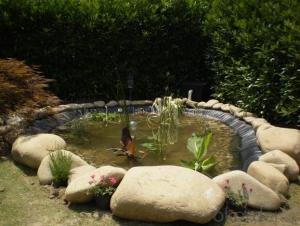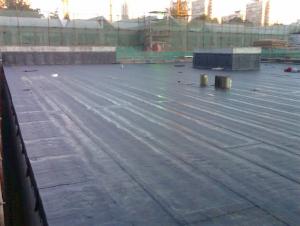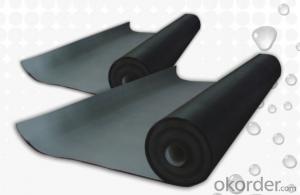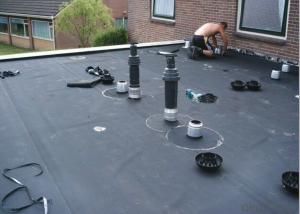EPDM Waterproofing Membrane for Manmade Pond
- Loading Port:
- Shanghai
- Payment Terms:
- TT OR LC
- Min Order Qty:
- 50000 m²
- Supply Capability:
- 5000000 m²/month
OKorder Service Pledge
OKorder Financial Service
You Might Also Like
EPDM Waterproofing Membrane for Manmade Pond
Description Of EPDM Waterproofing Membrane for Manmade Pond:
·Filament polyester filler base sheet material:
·The combination of filament polyester filler base and SBS modified bitumen forms an excellent comprehensive performance and high quality waterproof sheet material;
·High strength waterproof layer and strong water pressure resistance;
·Good performance of breaking resistance, tearing resistance, fatigue resistance, corrosion resistance, mould resistance and weather resistance;
·High tensile strength, high elongation, high adaptive capacity to base shrinkage deformation and fracture;
·Good resistance performance of low and high temperature: It could still work under -20℃ , be applicable to cold and hot regions, especially in chilly region;
·Good workability: It can be constructed by heat fusion method in the four seasons of the whole year and hot-joint is reliable and durable.
·Alkali-free glass fiber filler base sheet material:
·Combination of economical filler base and high performance SBS modified bitumen.
·Higher tensile strength, excellent resistance to high and low temperature.
·Good performance of corrosion resistance, mould resistance, weather resistance and good workability.
·Glass fiber reinforced polyester filler base sheet material:
·It is safe and eco-friendly by using mechanical mounting of construction.
·The product has better dimensional stabiliy.
Main Features of EPDM Waterproofing Membrane for Manmade Pond:
EPDM rubber waterproof membrane can operate in single layer, and is characterized by light weight, ageing resistance, with long service life, great tensile strength and high extension coefficient, which has strong adaptability to shrinkage, cracking and deformation in basic level. It can work well within -40°C to 100 °C and can be constructed with a single layer in ambient temperature. The service life of EPDM rubber waterproof membrane is up to 50 years, which is known as "King of Waterproof".
Specifications of EPDM Waterproofing Membrane for Manmade Pond:
Type | EPDM Rubber Waterproof Membrane | ||
Type | Vulcanized and Weldable | ||
Thickness | 1.2mm | 1.5mm | 2.0mm |
Weight(kg/m2) | 1.54-1.58 | 1.79-1.83 | 2.25-2.29 |
Size | 1.2m (width) * 20m (length)/roll. Weldable type could be 4m wide. | ||
Packing | 24㎡/roll, with plastic bag. (Weldable: 80㎡/roll) | ||
Usage | Roof, basement, pond, Lake, steel structure roofing, underground, tunnel, etc | ||
NO. | Item | Unit | Technical requirement | |
1 | Tolerance on size | Thickness | % | ±10 |
Width | % | ±1 | ||
length | % | Does not allow negative | ||
2 | Fracture tensile strength (normal temperature ) | Mpa | ≥7.5 | |
Fracture tensile strength(60 ℃) | Mpa | ≥2.3 | ||
3 | Breaking elongation,(normal temperature ) | % | ≥450 | |
Breaking elongation,(-20 ℃) | % | ≥200 | ||
4 | Tearing resistance | KN/m | ≥25 | |
5 | Impermeability | * | 0.3Mpa impermeable | |
6 | Bending at low temperature | °C | ≤-40 | |
7 | Elongation and contraction volume at heating | Elongation | mm | ≤2 |
contraction | mm | ≤4 | ||
8 | Hot air aging 80°CX168h | Fracture strength retention | % | ≥80 |
Rate of elongation at break | % | ≥70 | ||
9 | Alkaline (saturated Ca(OH)2 solution normal Temperature x2 168h ) | Fracture strength retention | % | ≥80 |
Rate of elongation at break | % | ≥80 | ||
10 | Ozone aging (40 degree by 168 hours ) | Elongation 40% , 500x10-2 | * | No Crack |
11 | Phytotron aging | Fracture strength retention | % | ≥80 |
Rate of elongation at break | % | ≥70 | ||
Applications of EPDM Waterproofing Membrane for Manmade Pond:
Widely used in roofs, basement, toilet ,swimming pool, and all kinds of industry and civil building waterproofing, reservoir, vivicism, bridge, underground, tunnel and dam waterproofing ,especially to the keystone waterproofing projects which is durability, high corrosion resistance and easy deformation.
Construction Site of EPDM Waterproofing Membrane for Manmade Pond:



IMages of EPDM Waterproofing Membrane for Manmade Pond:




FAQ of EPDM Waterproofing Membrane for Manmade Pond:
1. What are we supplying?
We are specialized in producing Colorful Asphalt Roof Shingle, SBS/APP modified bitumen waterproof membrane, Self adhesive bitumen waterproof membrane, PVC waterproofing membrane, EPDM rubber roofing membrane, Single Component Polyurethane Waterproof Coating, and Spray Polyurea Waterproof Coating
.
2. How Many years experience do we have?
We have been exported to more than 20 countries in the past 15 years.
3. How long do we usually reply your request?
We always reply our customer within 24 hours.
- Q:Can a waterproofing membrane be used for a water tank liner?
- Yes, a waterproofing membrane can be used for a water tank liner. Waterproofing membranes are specifically designed to prevent water penetration and can be applied to a variety of surfaces, including concrete, metal, and other materials commonly used in water tank construction. These membranes create a barrier that prevents leaks, cracks, and other forms of water damage, ensuring the integrity and longevity of the water tank. Additionally, waterproofing membranes are typically flexible, allowing them to conform to the shape of the tank and accommodate any movement or settlement that may occur. It is important, however, to select a waterproofing membrane that is specifically designed for water tank applications to ensure optimal performance and durability.
- Q:Is a waterproofing membrane suitable for below-grade applications?
- Yes, a waterproofing membrane is suitable for below-grade applications.
- Q:Does a waterproofing membrane require any specific surface preparation for tile installations?
- Yes, a waterproofing membrane typically requires specific surface preparation for tile installations. The surface needs to be clean, dry, and free of any dirt, dust, or debris. It is important to remove any loose or damaged tiles, repair any cracks or imperfections, and ensure the surface is smooth and level before applying the waterproofing membrane. This preparation ensures proper adhesion and a successful tile installation.
- Q:Can a waterproofing membrane be used on precast wood surfaces?
- Indeed, precast wood surfaces can benefit from the utilization of a waterproofing membrane. It is widely practiced to employ waterproofing membranes to shield diverse surfaces, such as wood, against water-related harm. These membranes are engineered with the purpose of establishing a barrier that obstructs the infiltration of water, thereby averting any potential structural problems or wood decay. By administering a waterproofing membrane to precast wood surfaces, one can successfully safeguard the wood from moisture and extend its durability. Nevertheless, it is crucial to verify the compatibility of the membrane with wood and adhere to the manufacturer's instructions for application in order to attain optimal outcomes.
- Q:How does a waterproofing membrane perform in areas with chemical exposure or solvents?
- A waterproofing membrane is designed to protect surfaces from water penetration and damage. However, its performance in areas with chemical exposure or solvents may vary depending on the type of membrane and the specific chemicals involved. In general, waterproofing membranes are not specifically designed to resist chemical exposure or solvents. While they may provide some level of resistance to certain chemicals, prolonged exposure or contact with aggressive chemicals can compromise their effectiveness. Chemicals can potentially degrade the membrane material, causing it to become brittle, crack, or lose its waterproofing properties over time. To enhance the performance of a waterproofing membrane in areas with chemical exposure or solvents, it is recommended to use a chemical-resistant membrane specifically designed for such environments. These specialized membranes are made of materials that have been tested to withstand the effects of various chemicals and solvents. They offer a higher level of protection and durability, ensuring longevity and preventing damage caused by chemical exposure. It is important to note that the choice of the appropriate waterproofing membrane for areas with chemical exposure or solvents should be made based on the specific chemicals involved and their concentration. Consulting with a professional waterproofing contractor or manufacturer is advisable to ensure the selection of the most suitable membrane for the intended application. Regular inspection and maintenance are also crucial to monitor the performance of a waterproofing membrane in chemical-exposed areas. Any signs of deterioration, such as cracks, leaks, or discoloration, should be addressed promptly to prevent further damage and potential water infiltration. Overall, while a waterproofing membrane can provide some level of protection in areas with chemical exposure or solvents, it is recommended to use a specialized chemical-resistant membrane for long-term performance and durability.
- Q:Can a waterproofing membrane be used in conjunction with other waterproofing methods?
- Yes, a waterproofing membrane can be used in conjunction with other waterproofing methods. In fact, it is quite common to combine multiple waterproofing techniques to provide enhanced protection against water intrusion. Waterproofing membranes are often used as a primary waterproofing layer, providing a barrier against water penetration. However, they can be further reinforced by using other methods such as sealants, coatings, or drainage systems. These additional methods can help to address specific vulnerabilities, such as cracks, joints, or areas prone to high water pressure. By combining different waterproofing techniques, it is possible to create a comprehensive and effective waterproofing system that offers maximum protection against water damage.
- Q:Can a waterproofing membrane be used for retaining walls?
- A waterproofing membrane is suitable for retaining walls as it helps to prevent water from penetrating and causing damage or structural failure. These membranes, made of materials like rubber, PVC, or bituminous compounds, are installed on the inner side of the retaining wall to create a barrier against water infiltration. In addition to protecting the wall's stability, some membranes also offer resistance to root penetration, UV protection, and flexibility to accommodate movement. However, it is crucial to consider factors such as the type of retaining wall, water pressure, and local climate conditions when selecting the right waterproofing membrane. It is advisable to consult with a professional engineer or contractor to ensure the most suitable waterproofing solution for your specific retaining wall project.
- Q:Are waterproofing membranes resistant to mold and mildew?
- Yes, waterproofing membranes are resistant to mold and mildew. They create a barrier that prevents moisture from seeping through, which helps inhibit the growth of mold and mildew.
- Q:Can a waterproofing membrane be installed in wet conditions?
- No, a waterproofing membrane should not be installed in wet conditions as it requires a dry surface to properly adhere and create an effective barrier against water penetration.
- Q:Can a waterproofing membrane be used in conjunction with paint or coatings?
- Yes, a waterproofing membrane can be used in conjunction with paint or coatings. The membrane provides a barrier against water intrusion, while the paint or coatings provide additional protection and aesthetic appeal.
1. Manufacturer Overview |
|
|---|---|
| Location | |
| Year Established | |
| Annual Output Value | |
| Main Markets | |
| Company Certifications | |
2. Manufacturer Certificates |
|
|---|---|
| a) Certification Name | |
| Range | |
| Reference | |
| Validity Period | |
3. Manufacturer Capability |
|
|---|---|
| a)Trade Capacity | |
| Nearest Port | |
| Export Percentage | |
| No.of Employees in Trade Department | |
| Language Spoken: | |
| b)Factory Information | |
| Factory Size: | |
| No. of Production Lines | |
| Contract Manufacturing | |
| Product Price Range | |
Send your message to us
EPDM Waterproofing Membrane for Manmade Pond
- Loading Port:
- Shanghai
- Payment Terms:
- TT OR LC
- Min Order Qty:
- 50000 m²
- Supply Capability:
- 5000000 m²/month
OKorder Service Pledge
OKorder Financial Service
Similar products
New products
Hot products
Hot Searches
Related keywords































